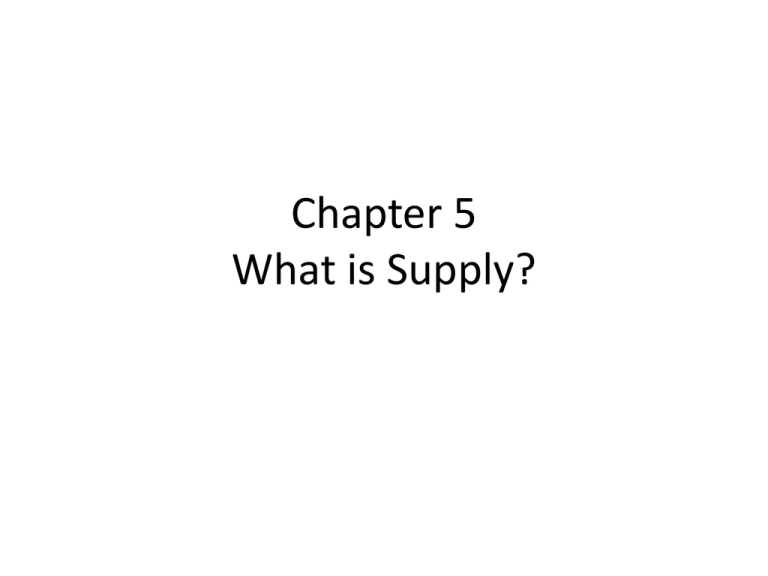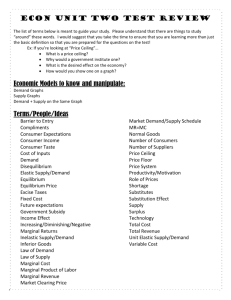Chapter 5 What is Supply?
advertisement

Chapter 5 What is Supply? Bell ringer • Transparency 14 Supply • The amount of product that would be offered to sale at all possible prices that could prevail in the market. • Law of Supply: the principle that the suppliers will normally offer more for sale at higher prices and less at lower prices. • Shows information for a single firm (and/or individual). – You = your labor is a service supplies Introduction to supply • Supply can be illustrated by a supply schedule or a supply curve. See figure 5.1 on page 118 • Supply schedule is a listing of the various quantities of a particular product supplied at all possible prices in a market. • Quantity goes up when $price goes up. • Supply curve graphically illustrates the supply schedule data. • Normally have a positive slope that goes up from the lower left-hand corner to the upper right-hand corner. Market Supply Curve • A graph that shows various amounts offered by all firms over a range of possible prices. • Example Figure 5.2 page 119 Activity 1 & 2- Chapter 5 • 1. Using the apple farm supply schedule create a supply curve and a supply market curve.(20 points) – Make sure you title the graphs correctly. – Make sure you label the graph correctly. – Use color markers or pencils to make graph visible. 2. Using the internet search for a supply schedule for an agriculture product and use excel to create a supply curve for you. (20 points) A Change in Quantity Supplied • Amount offered for sale at a given price. • Change in quantity supplied is the change in amount offered for sale in response to a change in price. – Can be an increase or decrease • Interaction of supply and demand usually determines the final price of the product Change in Supply • Several factors can contribute to a change in supply. – Cost of resources – Productivity – Technology – Taxes and subsidies – Expectations – Government regulations – Number of sellers Cost of Resources • A change in the cost of production inputs such as land, labor, and capital can cause a change in supply. • If the price of inputs drops, producers are willing to produce more, thereby the curve shifts to the right. • Increase in the costs has the opposite effect. Shift to the left Productivity • When management trains or motivates workers, productivity usually goes up. • Unhappy, unmotivated workers Technology • New technology shifts curve to right • Production cost go down makes it possible to produce more. • Example: – Milking machine, vaccinations, feed supplements Taxes & Subsidies • Tax viewed as a cost/increase in production costs • Taxes goes down • Subsidy: government payment to an individual, business, or other group to encourage or protect a certain type of economic activity. Lower the cost of production. • Examples of industries that receive subsidies • Wheat, cotton, corn, soybean, milk • Expectations: future prices of a product can affect supply. • Government regulations: if new regulations change the cost of production this can change the supply. Example Prop 2 • Number of sellers: change in number of sellers can change the market supply curve. • More sellers • Fewer sellers Elasticity of Supply • The response to a change in price varies for different products. • If an increase in price leads to a proportionally large increase in outputs, supply is elastic. • Proportionally small change in outputs is inelastic. Determinants of supply elasticity • Firms that can adjust to new prices quickly elastic. • If nature of production is such that adjustments take longer this is inelastic. • Activity: list 2 agriculture industries that have elastic and inelastic supply and explain why? Chapter 5, Section 1 Review • Page 125 • Questions 2-8. Chapter 5, Section 2 • The Production Function: shows how outputs changes when a variable input such as labor changes. • See figure 5.5 • Make a production schedule and production function curve. • Short run: a period that is so brief that only the amount of the variable input can be changed. • Long run: changes during a longer period of time that a firm can adjust the quantities of all productive resources, including capital. – Examples: Car dealers shut down some dealers now and will have to close down production lines because the amount of capital used for production changes. – Example: Total Production • Total out put produced by firm. • Short term relationship • Only one variable changes and other resources remain unchanged. Marginal Production • Extra output or change in total production caused by adding one more unit of variable input. • Sum of marginal production= total production • See page 128 figure 5.5 Stages of Production • Help companies determine the most profitable number of workers to hire. • Stage 1- Increasing Marginal Returns • Stage 2- Decreasing marginal Returns • Stage 3- Negative Marginal Returns Stage 1 • As long as each worker contributes more to total output than the worker before, total output rises at an increasing rate. Stage 2 • Production keeps growing, but it does by smaller and smaller amount. • Each additional worker then, is making a diminishing, but still positive, contribution to total output. Stage 3 • Outputs start to fall • Marginal products of additional workers are negative. • Workers are not as efficient and production decreases. Chapter 5, Section 2 review • Page 130 • Questions 2-7 Chapter 5 Section 3 • Measures of Cost: Business analyzed fixed, variable, total, and marginal costs to make production decisions. • All used to keep an eye on their costs. Fixed Costs • The costs that an organization incurs even if there is little or no activity. • It makes no difference whether the business produces nothing, very little, or a large amount. • Sometimes called overhead • Includes salaries paid to executives, interest charges on bonds, rent payments on leased properties, state and local taxes • Also includes depreciation on capital goods Variable Costs • Costs that changes when business rate of operation or outputs change. • Usually associated with labor and raw materials. Labor, power, freight charges • Largest variable labor Total Cost • the sum of the fixed and variable costs, taking in account all of the cost a business faces in the course of operation. Marginal Cost • The extra cost incurred when producing one more unit of output. • See page 134 for examples using figure 5.6 Applying Cost Principles • Fixed and variable costs affect the way a business operated. • Internet business: fixed costs of operation, on the Internet are so low. Also no need for large inventory. Break-Even Point • The level of production that generates just enough revenue to cover its total operating costs. Marginal Analysis and Profit Maximization • Businesses compare marginal revenue with marginal cost to find the level of production that maximizes profits. • Businesses use two key measures of revenue to find the amount of outputs that will produce the greatest profit. – Total revenue: all revenue that the business receives. – Marginal revenue : the extra revenue a business receives from the production and sale of one additional unit of production. Dividing the change in total revenue by the marginal product Marginal Analysis: • Decision making that compares the extra costs of doing something to the extra benefits gained. Profit Maximization Quantity of Output • Level of production where marginal cost is equal to marginal revenue. • Marginal cost = marginal revenue – Extra cost for making one more = extra revenue from addition production or one additional unit or output. Chapter 5 Section 3 Review • Page 137 Questions 2-7 Chapter 5 review • • • • • • • • Page 140-141 Review Content Vocabulary 1-12 Review main Ideas 19-28 Critical Thinking 29-34 Applying Economic concepts 36 Thinking Like an Economist 37 Analyzing Visuals 38 Test will be on Chapt. 4 & 5 Supply & Demand









